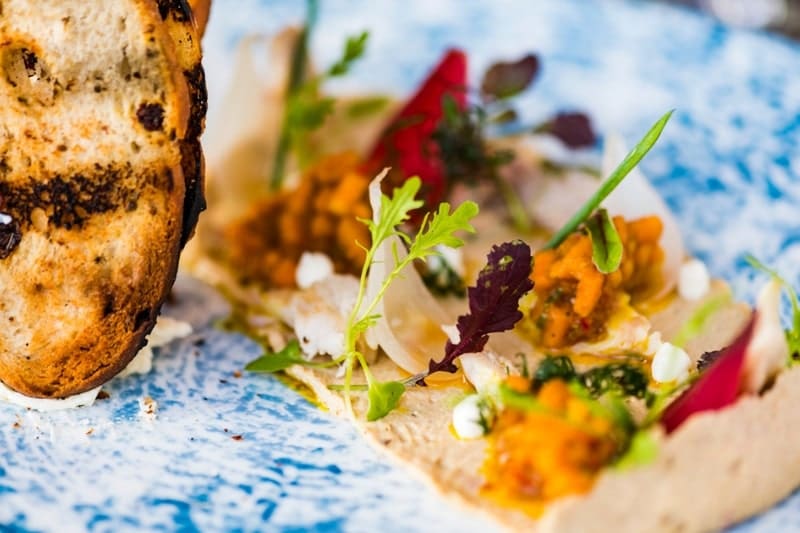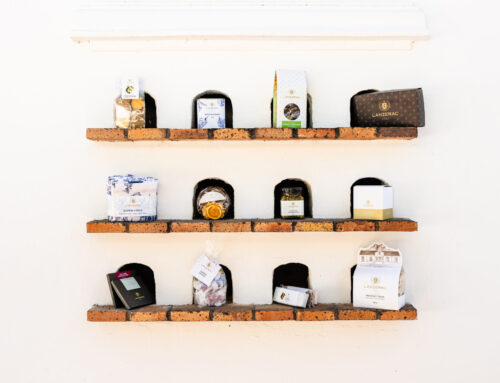We used three of our favourite recipes to prepare one beautiful autumn dish which you can try out at home.
The weather’s turning, the leaves are falling and all over Stellenbosch the air is crisp and ripe with the promise of the coming winter.
Now is the time to break out your favourite sweaters and enjoy warm, exotic, spiced foods in close quarters before the real cold sets in and makes even leaving bed an unpleasant affair!
If you can’t make it to Lanzerac this Autumn, we’ll bring Lanzerac to you!
With three of our favourite autumn recipes, you too can enjoy a little Lanzerac luxury in the comfort of your own home!
For expert tips on preparing world-class snoek pâté, delectable curried papaya and mouthwatering mosbolletjies, read on.

Citrus Cured Snoek Pâté
Makes 6 portions.
Ingredients:
- 1 butterflied snoek (most fishmongers will butterfly the snoek for you)
- 1 small onion
- 1 red chilli
- 1 clove of garlic
- 20g of fresh ginger (peeled)
- 100ml olive oil
- 25g butter
- 60ml thick cream (1/4 cup)
- 60g cream cheese
- 15ml lemon juice
- Salt and freshly ground black pepper (to taste)
For the Curing:
- 200g coarse salt
- 200g sugar
- 2 lemons
- 1 grapefruit
- 10g parsley
- 10g coriander
- 10g thyme
- 5g pink or white peppercorns

Instructions:
Step 1. You will need to cure the fish the night before you want to make/consume the pâté.
Step 2. Place the butterflied snoek in a container (ideally with an airtight lid) that will fit in your fridge.
If you do not have a tray or container that will be big enough for the whole butterflied snoek, you can go ahead and cut the snoek into manageably sized pieces (you will be flaking the fish later so it doesn’t need to be whole – leaving it whole does, however, make managing the fish easier in the initial stages).
Step 3. Combine all the dry ingredients along with the herbs in a mixing bowl.
Zest the lemons and grapefruit and add the zest to the dry mix. Mix well before spreading the rub over the fish (both sides).
Step 4. Slice the citrus fruits and add roughly 6 to 8 slices of each fruit to the container.
You can lie the fruit slices on top of or alongside the fish.
Seal the container and leave in the fridge overnight or for a minimum of 8 hours.
Step 5. After the fish has been cured overnight, you can remove the container from the fridge and rinse all the curing ingredients off the snoek.
Rinse the fish thoroughly or your final product may be overwhelmingly salty.
Also rinsing off your fruit slices and fresh herbs to reuse in the baking process is a great idea as this gives your snoek a really intense flavour!
Step 6. Pat the snoek dry using kitchen paper towels or a clean dish towel.
Step 7. Preheat your oven to 200 degrees celsius.
Place the fish skin-side down on an oven tray and drizzle with olive oil.
Place the herbs and citrus slices you salvaged from the curing stage on one half of the snoek and fold the undressed side over (to cover the dressed side, like a little snoek sandwich).
Score 3 deep cuts across the snoeak skin, drizzle with olive oil, and repeat on the other side.
Step 8. Bake the snoek in the preheated oven for 20 – 25min.
Step 9. While your snoek is in the oven, finely mince the onion, chilli, ginger and garlic.
Sauté in a pan with a little olive oil and butter.
You don’t want to colour this too much, you are just looking to cook the onions through and bring them up to a little caramel colour.
Remove from plate and allow to cool.
Step 10. When the snoek is cooked, remove it from the oven.
Put aside and allow to cool.
Step 11. When cool enough to handle, open up the fish, remove all herbs and citrus slices, then flake all the fish into a kitchen processor bowl, removing all bones and skin (Always make sure that you clean your hands thoroughly or wear kitchen gloves before handling the meat).
Add any juices that are left in the roasting tray to the flaked snoek, and discard the skin and bones.
Step 12. Add the onion mix to the flaked snoek along with the cream cheese, cream and season with a little salt and pepper.
Step 13. Put the bowl into the food processor and blitz or mince until all the ingredients are well combined.
You can decide just how smooth or textured you would like your pâté to be.
Add lemon juice to taste.
Serving Suggestion:
Serve with mosbolletjie toast, beetroot & rosemary pickled onions, coriander and an aromatic papaya curry.
Pairs perfectly with the Lanzerac Chenin Blanc.
Notes:
*Be wary not to overprocess the pâté in pursuit of a smooth texture or you risk churning the cream cheese to the point of producing a lumpy pâté with a fatty texture.
*For a more rustic, textured pâté, try whisking the final mixture by hand instead of using a food processor.

Curried Papaya
Ingredients:
- 2 large papayas, peeled, cleaned & diced
- ½ Coconut (Grated) (Dessicated will work if you rehydrate it prior to use)
- 1 Onion, minced
- 2 Green Chillies, chopped
- 2tsp Turmeric
- 25g Ginger, peeled and minced
- 2tsp Yellow mustard seeds
- 2tsp mild & spicy curry
- 2-3 Curry leaves
- 1 Lime, juiced
- 1tsp Cumin seeds
- 50mls Coconut oil, ghee or clarified butter
- ½ tin Coconut milk
- 5g Coriander, fresh
- Salt (to taste)
Instructions:
Step 1. Heat a pan and sauté the mustard and cumin seeds. When they begin to pop add the onion, chilli, ginger and curry leaves, along with the coconut oil or ghee.
Step 2. Add 1/3 of the diced papaya along with the grated coconut and sauté for a few minutes. If you feel that the mixture is getting a little dry, add more of the coconut oil or ghee as needed.
Step 3. Add the turmeric, curry, pinch of salt and 125ml of water to the pan. Reduce the heat and allow to simmer until you feel the papaya softening up and the liquid has reduced. Stir occasionally.
Step 4. Add 2/3 of this mix to a blender or food processor and blend into a paste. Add this back into the pan with the remaining 1/3 of the spiced papaya and coconut mix.
Step 5. Add the coconut milk and cook until you have a thick curry sauce. Add the rest of the diced papaya and cook for 3 – 4 min. Add the fresh lime juice.
Step 6. Check the seasoning. Add salt as needed.
Step 7. Leave to cool and discard any large pieces of curry leaf that you find in the curry once cool.
Step 8. Chop the fresh coriander and add it to the chunky papaya curry.

Mosbolletjie
Makes: 3 Loaves or 36 Buns.
Ingredients:
Raisin Ferment Makes: 876G
- 750g Luke warm water
- 125g Bruised Raisins
- 1g Yeast
Sourdough Base Makes: 740G
- 240g Raisin Ferment
- 500g All-purpose flour
Final Dough Makes: 3KG
- 740g Sourdough base
- 1670g All-purpose flour
- 400-500g Raisin ferment
- 265g Sugar
- 32g Salt
- 16g Yeast
- 7g Aniseed
- 100g Eggs
- 167g Butter, softened
Egg Wash:
- 1 egg
- 5g sugar
- 2g salt
- 30ml milk
Instructions:
Step 1. Start by preparing your raisin ferment.
Step 2. In a large container, mix your ingredients together and let this stand for 24 to 48 hours before straining the mixture through a muslin cloth and discarding the raisins.
Step 3. Next, prepare your sourdough.
Step 4. Add the flour along with the room temperature raisin ferment liquid into a mixer and work until it combines to a fairly wet, spongy mixture.
Put this in an airtight container and refrigerate for 24 hours.
Step 5. Next, prepare the mosbolletjie dough.
Step 6. In a large bowl mix the flour, sourdough, raisin ferment, butter, salt, sugar, yeast, aniseed and egg.
Work in a mixer until fully combined.

Step 7. Turn out dough onto a lightly floured surface and knead for 5 -10 minutes, or until the dough is soft and elastic.
Step 8. Place in a large oiled bowl, then cover and leave to rise in a warm place for about 30 minutes, until the dough has doubled in size.
Step 9. Pour out the dough onto a floured surface, and knead until smooth.
Step 10. Divide the dough into 16 equal pieces (about 110 g each) and shape into balls using oiled hands.
Step 11. Pack the balls tightly into 2 loaf tins, with 8 balls in each.
Step 12. Cover and leave to rise for about 30 – 45 minutes.
Step 13. Meanwhile, preheat the oven to 200 degrees celsius.
Step 14. While your oven is preheating, prepare your egg wash by lightly heating the milk before adding the sugar and salt.
Stir until the sugar and salt dissolve. Allow to cool before beating in 1 egg.
Use this mixture to glaze your mosbolletjie(s) by lightly brushing the mixture over the top of your dough just before you put the dough in the oven.
Step 15. Bake for 30 minutes or until golden brown on top.
Pro Tip: give the dough a quick jet of steam after a few minutes in the oven.
To do this at home you can add a cup of water in a tray to the bottom of the oven.
While non-essential this will improve your final product.
Step 16. Turn out onto wire racks and leave to cool slightly.
Eat warm, or break into pieces for use in another recipe or to store.
Step 17. Leftover mosbolletjie can be used to make mosbolletjie rusks after a day or so.
If you’re an Autumn gormound who prefers exceptional service and an indulgent atmosphere to a “do-it-yourself” solution; why not visit Lanzerac Wine Estate Hotel and Spa this Autumn to see (and taste) how the professionals do it?
At Lanzerac you can have all the pleasure of all the mouthfuls and all the exquisite flavour, with no elbow-grease required!
Food always tastes better when it’s expertly prepared, served, and enjoyed with a Lanzerac wine.
To book your stay at Lanzerac, or to make a reservation for a meal, please feel free to contact us.
Also read:
5 Stellenbosch Restaurants You Should Try When You’re In Town
16 Expert South African Food Bloggers Share Their Favourite Deli Recipes With Lanzerac!
Awesome Things To Do In Stellenbosch When You’re In Town

















